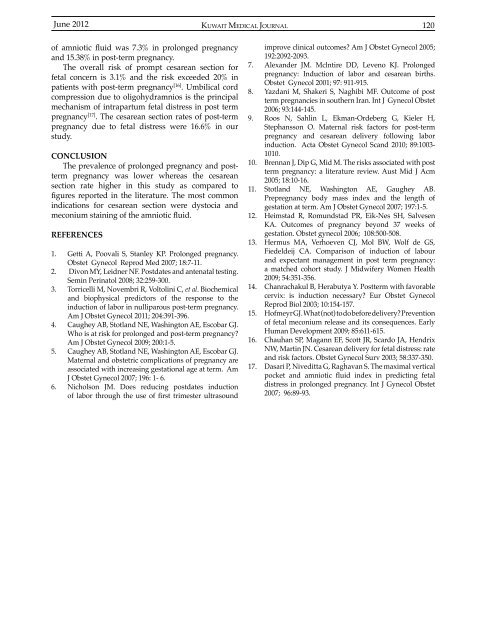Vol 44 # 2 June 2012 - Kma.org.kw
Vol 44 # 2 June 2012 - Kma.org.kw
Vol 44 # 2 June 2012 - Kma.org.kw
You also want an ePaper? Increase the reach of your titles
YUMPU automatically turns print PDFs into web optimized ePapers that Google loves.
<strong>June</strong> <strong>2012</strong><br />
KUWAIT MEDICAL JOURNAL 120<br />
of amniotic fluid was 7.3% in prolonged pregnancy<br />
and 15.38% in post-term pregnancy.<br />
The overall risk of prompt cesarean section for<br />
fetal concern is 3.1% and the risk exceeded 20% in<br />
patients with post-term pregnancy [16] . Umbilical cord<br />
compression due to oligohydramnios is the principal<br />
mechanism of intrapartum fetal distress in post term<br />
pregnancy [17] . The cesarean section rates of post-term<br />
pregnancy due to fetal distress were 16.6% in our<br />
study.<br />
CONCLUSION<br />
The prevalence of prolonged pregnancy and postterm<br />
pregnancy was lower whereas the cesarean<br />
section rate higher in this study as compared to<br />
figures reported in the literature. The most common<br />
indications for cesarean section were dystocia and<br />
meconium staining of the amniotic fluid.<br />
REFERENCES<br />
1. Getti A, Poovali S, Stanley KP. Prolonged pregnancy.<br />
Obstet Gynecol Reprod Med 2007; 18:7-11.<br />
2. Divon MY, Leidner NF. Postdates and antenatal testing.<br />
Semin Perinatol 2008; 32:259-300.<br />
3. Torricelli M, Novembri R, <strong>Vol</strong>tolini C, et al. Biochemical<br />
and biophysical predictors of the response to the<br />
induction of labor in nulliparous post-term pregnancy.<br />
Am J Obstet Gynecol 2011; 204:391-396.<br />
4. Caughey AB, Stotland NE, Washington AE, Escobar GJ.<br />
Who is at risk for prolonged and post-term pregnancy?<br />
Am J Obstet Gynecol 2009; 200:1-5.<br />
5. Caughey AB, Stotland NE, Washington AE, Escobar GJ.<br />
Maternal and obstetric complications of pregnancy are<br />
associated with increasing gestational age at term. Am<br />
J Obstet Gynecol 2007; 196: 1- 6.<br />
6. Nicholson JM. Does reducing postdates induction<br />
of labor through the use of first trimester ultrasound<br />
improve clinical outcomes? Am J Obstet Gynecol 2005;<br />
192:2092-2093.<br />
7. Alexander JM. Mclntire DD, Leveno KJ. Prolonged<br />
pregnancy: Induction of labor and cesarean births.<br />
Obstet Gynecol 2001; 97: 911-915.<br />
8. Yazdani M, Shakeri S, Naghibi MF. Outcome of post<br />
term pregnancies in southern Iran. Int J Gynecol Obstet<br />
2006; 93:1<strong>44</strong>-145.<br />
9. Roos N, Sahlin L, Ekman-Ordeberg G, Kieler H,<br />
Stephansson O. Maternal risk factors for post-term<br />
pregnancy and cesarean delivery following labor<br />
induction. Acta Obstet Gynecol Scand 2010; 89:1003-<br />
1010.<br />
10. Brennan J, Dip G, Mid M. The risks associated with post<br />
term pregnancy: a literature review. Aust Mid J Acm<br />
2005; 18:10-16.<br />
11. Stotland NE, Washington AE, Gaughey AB.<br />
Prepregnancy body mass index and the length of<br />
gestation at term. Am J Obstet Gynecol 2007; 197:1-5.<br />
12. Heimstad R, Romundstad PR, Eik-Nes SH, Salvesen<br />
KA. Outcomes of pregnancy beyond 37 weeks of<br />
gestation. Obstet gynecol 2006; 108:500-508.<br />
13. Hermus MA, Verhoeven CJ, Mol BW, Wolf de GS,<br />
Fiedeldeij CA. Comparison of induction of labour<br />
and expectant management in post term pregnancy:<br />
a matched cohort study. J Midwifery Women Health<br />
2009; 54:351-356.<br />
14. Chanrachakul B, Herabutya Y. Postterm with favorable<br />
cervix: is induction necessary? Eur Obstet Gynecol<br />
Reprod Biol 2003; 10:154-157.<br />
15. Hofmeyr GJ. What (not) to do before delivery? Prevention<br />
of fetal meconium release and its consequences. Early<br />
Human Development 2009; 85:611-615.<br />
16. Chauhan SP, Magann EF, Scott JR, Scardo JA, Hendrix<br />
NW, Martin JN. Cesarean delivery for fetal distress: rate<br />
and risk factors. Obstet Gynecol Surv 2003; 58:337-350.<br />
17. Dasari P, Niveditta G, Raghavan S. The maximal vertical<br />
pocket and amniotic fluid index in predicting fetal<br />
distress in prolonged pregnancy. Int J Gynecol Obstet<br />
2007; 96:89-93.
















